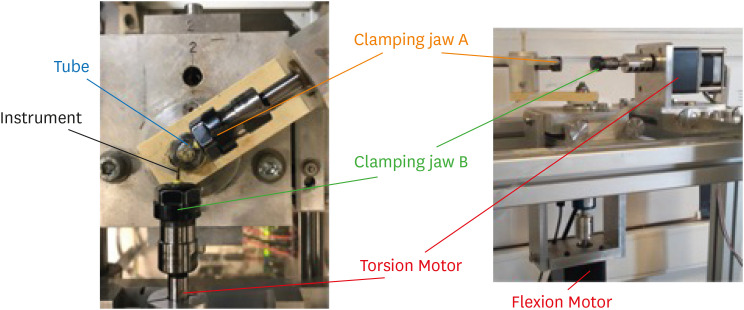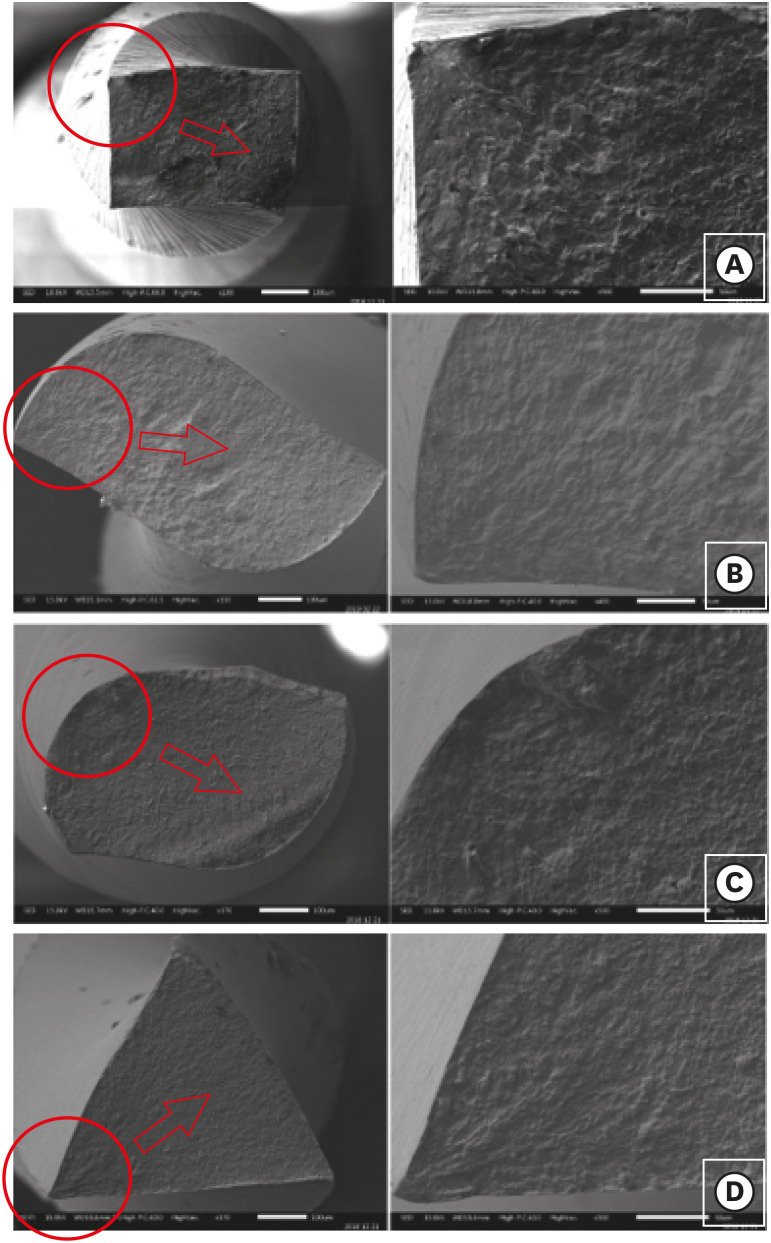Restor Dent Endod.
2022 May;47(2):e16. 10.5395/rde.2022.47.e16.
Comparison of the cyclic fatigue resistance of One Curve, F6 Skytaper, Protaper Next, and Hyflex CM endodontic files
- Affiliations
-
- 1Department of Pediatric Dentistry, Dental School-Hospital of Brest, France
- 2University of Bretagne Occidentale, Brest, France
- 3Ecole Nationale d’Ingénieurs de Brest, Brest, France
- 4Department of Endodontics and Restorative Dentistry, Dental School-Hospital of Brest, University of Bretagne Occidentale, Brest, France
- 5Laboratory of Medical Information Processing, Brest, France
- KMID: 2548120
- DOI: http://doi.org/10.5395/rde.2022.47.e16
Abstract
Objectives
This study compared the cyclic fatigue resistance of One Curve (C wire) and F6 Skytaper (conventional austenite nickel-titanium [NiTi]), and 2 instruments with thermomechanically treated NiTi: Protaper Next X2 (M wire) and Hyflex CM (CM wire).
Materials and Methods
Ten new instruments of each group (size: 0.25 mm, 6% taper in the 3 mm tip region) were tested using a rotary bending machine with a 60° curvature angle and a 5 mm curvature radius, at room temperature. The number of cycles until fracture was recorded. The length of the fractured instruments was measured. The fracture surface of each fragment was examined with a scanning electron microscope (SEM). The data were analyzed using oneway analysis of variance and the post hoc Tukey test. The significance level was set at 0.05.
Results
At 60°, One Curve, F6 Skytaper and Hyflex CM had significantly longer fatigue lives than Protaper Next X2 (p < 0.05). No statistically significant differences were found in the cyclic fatigue lives of One Curve, F6 Skytaper, and Hyflex CM (p > 0.05). SEM images of the fracture surfaces of the different instruments showed typical features of fatigue failure.
Conclusions
Within the conditions of this study, at 60° and with a 5 mm curvature radius, the cyclic fatigue life of One Curve was not significantly different from those of F6 Skytaper and Hyflex CM. The cyclic fatigue lives of these 3 instruments were statistically significantly longer than that of Protaper Next.
Keyword
Figure
Reference
-
1. Neurohr AJ, Dunand DC. Shape-memory NiTi with two-dimensional networks of micro-channels. Acta Biomater. 2011; 7:1862–1872. PMID: 21130189.2. Frotscher M, Kahleyss F, Simon T, Biermann D, Eggeler G. Achieving small structures in thin NiTi sheets for medical applications with water jet and micro machining: a comparison. J Mater Eng Perform. 2011; 20:776–782.3. Stoeckel D. Nitinol medical devices and implants. Minim Invasive Ther Allied Technol. 2000; 9:81–88.
Article4. Oshida Y. Bioscience and bioengineering of titanium materials. 1st ed. Amsterdam, Holland: Elsevier;2007.5. Thompson SA. An overview of nickel-titanium alloys used in dentistry. Int Endod J. 2000; 33:297–310. PMID: 11307203.
Article6. Peters OA. Current challenges and concepts in the preparation of root canal systems: a review. J Endod. 2004; 30:559–567. PMID: 15273636.7. Parashos P, Messer HH. Rotary NiTi instrument fracture and its consequences. J Endod. 2006; 32:1031–1043. PMID: 17055902.
Article8. Çapar ID, Arslan H. A review of instrumentation kinematics of engine-driven nickel-titanium instruments. Int Endod J. 2016; 49:119–135. PMID: 25630977.
Article9. Yared G. Canal preparation using only one Ni-Ti rotary instrument: preliminary observations. Int Endod J. 2008; 41:339–344. PMID: 18081803.
Article10. Franco V, Fabiani C, Taschieri S, Malentacca A, Bortolin M, Del Fabbro M. Investigation on the shaping ability of nickel-titanium files when used with a reciprocating motion. J Endod. 2011; 37:1398–1401. PMID: 21924190.
Article11. Bürklein S, Hinschitza K, Dammaschke T, Schäfer E. Shaping ability and cleaning effectiveness of two single-file systems in severely curved root canals of extracted teeth: Reciproc and WaveOne versus Mtwo and ProTaper. Int Endod J. 2012; 45:449–461. PMID: 22188401.
Article12. Mohammadi Z, Soltani MK, Shalavi S, Asgary S. A Review of the various surface treatments of NiTi Instruments. Iran Endod J. 2014; 9:235–240. PMID: 25386201.13. Aun DP, Peixoto IF, Houmard M, Buono VT. Enhancement of NiTi superelastic endodontic instruments by TiO2 coating. Mater Sci Eng C. 2016; 68:675–680.14. Lopes HP, Elias CN, Vieira MV, Vieira VT, de Souza LC, Dos Santos AL. Influence of surface roughness on the fatigue life of nickel-titanium rotary endodontic instruments. J Endod. 2016; 42:965–968. PMID: 27080117.
Article15. Zupanc J, Vahdat-Pajouh N, Schäfer E. New thermomechanically treated NiTi alloys - a review. Int Endod J. 2018; 51:1088–1103. PMID: 29574784.
Article16. Pereira ES, Peixoto IF, Viana AC, Oliveira II, Gonzalez BM, Buono VT, Bahia MG. Physical and mechanical properties of a thermomechanically treated NiTi wire used in the manufacture of rotary endodontic instruments. Int Endod J. 2012; 45:469–474. PMID: 22188417.
Article17. Alapati SB, Brantley WA, Iijima M, Clark WA, Kovarik L, Buie C, Liu J, Ben Johnson W. Metallurgical characterization of a new nickel-titanium wire for rotary endodontic instruments. J Endod. 2009; 35:1589–1593. PMID: 19840654.
Article18. Siu C, Marshall JG, Baumgartner JC. An in vivo comparison of the Root ZX II, the Apex NRG XFR, and Mini Apex Locator by using rotary nickel-titanium files. J Endod. 2009; 35:962–965. PMID: 19567315.
Article19. Kaval ME, Capar ID, Ertas H, Sen BH. Comparative evaluation of cyclic fatigue resistance of four different nickel-titanium rotary files with different cross-sectional designs and alloy properties. Clin Oral Investig. 2017; 21:1527–1530.
Article20. Serafin M, De Biasi M, Franco V, Angerame D. In vitro comparison of cyclic fatigue resistance of two rotary single-file endodontic systems: OneCurve versus OneShape. Odontology. 2019; 107:196–201. PMID: 30255216.
Article21. Shen Y, Coil JM, Zhou H, Zheng Y, Haapasalo M. HyFlex nickel-titanium rotary instruments after clinical use: metallurgical properties. Int Endod J. 2013; 46:720–729. PMID: 23330612.
Article22. Ninan E, Berzins DW. Torsion and bending properties of shape memory and superelastic nickel-titanium rotary instruments. J Endod. 2013; 39:101–104. PMID: 23228266.
Article23. Topçuoğlu HS, Topçuoğlu G, Akti A, Düzgün S. In vitro comparison of cyclic fatigue resistance of ProTaper Next, HyFlex CM, OneShape, and ProTaper universal instruments in a canal with a double curvature. J Endod. 2016; 42:969–971. PMID: 27091353.
Article24. Tobushi H, Nakahara T, Shimeno Y, Hashimoto T. Low-cycle fatigue of Ni-Ti shape memory alloy and formulation of fatigue life. J Eng Mater Technol. 2000; 122:186–191.
Article25. Shen Y, Qian W, Abtin H, Gao Y, Haapasalo M, Haapasalo M. Effect of environment on fatigue failure of controlled memory wire nickel-titanium rotary instruments. J Endod. 2012; 38:376–380. PMID: 22341078.
Article26. Vadhana S, SaravanaKarthikeyan B, Nandini S, Velmurugan N. Cyclic fatigue resistance of RaCe and Mtwo rotary files in continuous rotation and reciprocating motion. J Endod. 2014; 40:995–999. PMID: 24935551.
Article27. Grande NM, Plotino G, Pecci R, Bedini R, Malagnino VA, Somma F. Cyclic fatigue resistance and three-dimensional analysis of instruments from two nickel-titanium rotary systems. Int Endod J. 2006; 39:755–763. PMID: 16948660.
Article28. La Rosa GR, Palermo C, Ferlito S, Isola G, Indelicato F, Pedullà E. Influence of surrounding temperature and angle of file access on cyclic fatigue resistance of two single file nickel-titanium instruments. Aust Endod J. 2021; 47:260–264. PMID: 33277785.
Article29. Rubio J, Zarzosa JI, Pallarés A. A comparative study of cyclic fatigue of 10 different types of endodontic instruments: an in vitro study. Acta Stomatol Croat. 2019; 53:28–36. PMID: 31118530.
Article30. Cheung GS, Zhang EW, Zheng YF. A numerical method for predicting the bending fatigue life of NiTi and stainless steel root canal instruments. Int Endod J. 2011; 44:357–361. PMID: 21219364.
Article31. Capar ID, Ertas H, Arslan H. Comparison of cyclic fatigue resistance of novel nickel-titanium rotary instruments. Aust Endod J. 2015; 41:24–28. PMID: 24697976.
Article32. Elnaghy AM, Elsaka SE. Cyclic fatigue resistance of One Curve, 2Shape, ProFile Vortex, Vortex Blue, and RaCe nickel-titanium rotary instruments in single and double curvature canals. J Endod. 2018; 44:1725–1730. PMID: 30409450.
Article33. Ye J, Gao Y. Metallurgical characterization of M-Wire nickel-titanium shape memory alloy used for endodontic rotary instruments during low-cycle fatigue. J Endod. 2012; 38:105–107. PMID: 22152631.
Article34. Shen Y, Zhou HM, Zheng YF, Campbell L, Peng B, Haapasalo M. Metallurgical characterization of controlled memory wire nickel-titanium rotary instruments. J Endod. 2011; 37:1566–1571. PMID: 22000465.
Article35. Iacono F, Pirani C, Generali L, Bolelli G, Sassatelli P, Lusvarghi L, Gandolfi MG, Giorgini L, Prati C. Structural analysis of HyFlex EDM instruments. Int Endod J. 2017; 50:303–313. PMID: 26864081.36. Testarelli L, Plotino G, Al-Sudani D, Vincenzi V, Giansiracusa A, Grande NM, Gambarini G. Bending properties of a new nickel-titanium alloy with a lower percent by weight of nickel. J Endod. 2011; 37:1293–1295. PMID: 21846552.
Article37. Pongione G, Pompa G, Milana V, Di Carlo S, Giansiracusa A, Nicolini E, De Angelis F. Flexibility and resistance to cyclic fatigue of endodontic instruments made with different nickel-titanium alloys: a comparative test. Ann Stomatol (Roma). 2012; 3:119–122. PMID: 23386933.38. Santos LA, Bahia MG, de Las Casas EB, Buono VT. Comparison of the mechanical behavior between controlled memory and superelastic nickel-titanium files via finite element analysis. J Endod. 2013; 39:1444–1447. PMID: 24139271.
Article39. Pereira ES, Viana AC, Buono VT, Peters OA, Bahia MG. Behavior of nickel-titanium instruments manufactured with different thermal treatments. J Endod. 2015; 41:67–71. PMID: 25112810.
Article40. Goo HJ, Kwak SW, Ha JH, Pedullà E, Kim HC. Mechanical properties of various heat-treated nickel-titanium rotary instruments. J Endod. 2017; 43:1872–1877. PMID: 28951028.
Article41. Soares RG, Lopes HP, Elias CN, Vieira MV, Vieira VT, de Paula CB, Alves FR. Comparative study of the mechanical properties of instruments made of conventional, M-wire, R-phase, and controlled memory nickel-titanium alloys. ENDO. 2017; 11:271–277.42. Zhou HM, Shen Y, Zheng W, Li L, Zheng YF, Haapasalo M. Mechanical properties of controlled memory and superelastic nickel-titanium wires used in the manufacture of rotary endodontic instruments. J Endod. 2012; 38:1535–1540. PMID: 23063231.
Article43. Capar ID, Kaval ME, Ertas H, Sen BH. Comparison of the cyclic fatigue resistance of 5 different rotary pathfinding instruments made of conventional nickel-titanium wire, M-wire, and controlled memory wire. J Endod. 2015; 41:535–538. PMID: 25510316.
Article44. Pedullà E, Lo Savio F, Boninelli S, Plotino G, Grande NM, Rapisarda E, La Rosa G. Influence of cyclic torsional preloading on cyclic fatigue resistance of nickel - titanium instruments. Int Endod J. 2015; 48:1043–1050. PMID: 25353957.
Article
- Full Text Links
- Actions
-
Cited
- CITED
-
- Close
- Share
- Similar articles
-
- Comparison of the cyclic fatigue resistance of VDW.ROTATE, TruNatomy, 2Shape, and HyFlex CM nickel-titanium rotary files at body temperature
- Cyclic fatigue, bending resistance, and surface roughness of ProTaper Gold and EdgeEvolve files in canals with single- and double-curvature
- Effect of adaptive motion on cyclic fatigue resistance of a nickel titanium instrument designed for retreatment
- In vitro comparison of the cyclic fatigue resistance of HyFlex EDM, One G, and ProGlider nickel titanium glide path instruments in single and double curvature canals
- The effects of autoclave sterilization on the cyclic fatigue resistance of ProTaper Universal, ProTaper Next, and ProTaper Gold nickel-titanium instruments



